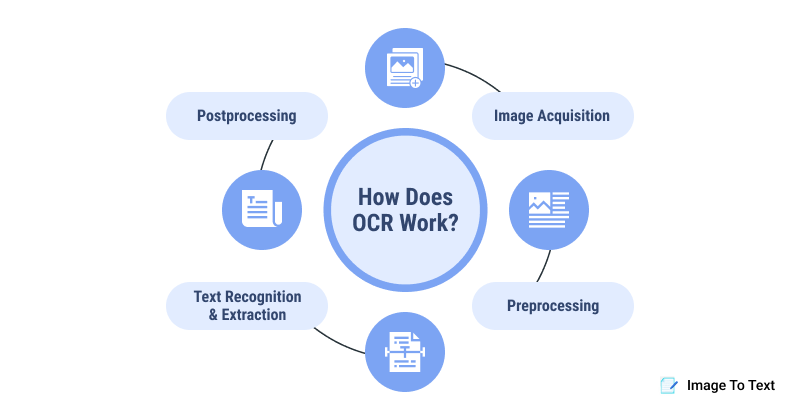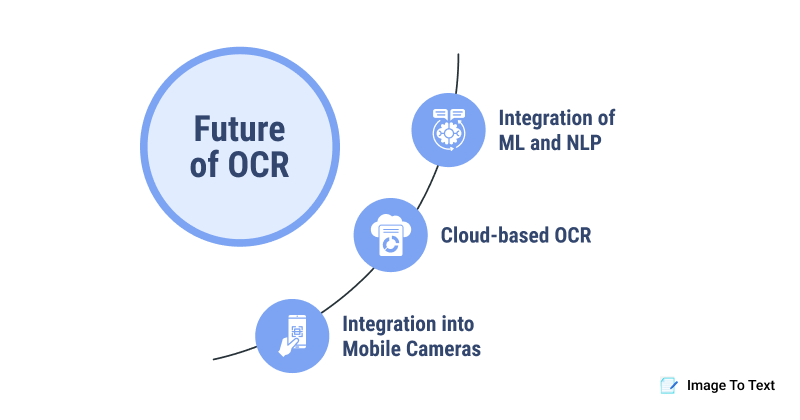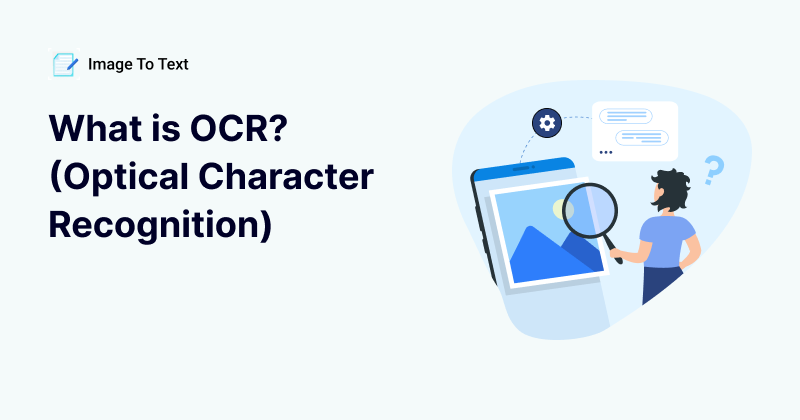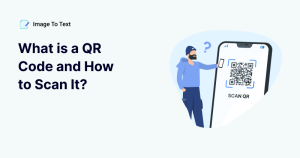What is OCR? (Optical Character Recognition)
Just think about a world where scanned documents or textual images can be instantly converted into editable text for easy accessibility and shareability. Luckily, this isn’t a fictional thought now. Instead, it is a reality brought to us by OCR.
This technology has completely automated data extraction from documents, images, invoices, medical records, etc., ensuring streamlined workflows. It has become a go-to choice for many individuals and industries worldwide.
To learn more about this fascinating technology, you have to keep reading this blog till the end. The article will cover every bit of detail about OCR, so let’s fire away.
What is OCR?
OCR (Optical Character Recognition) is basically a pattern-based recognition that efficiently scans documents and images to extract all the information in an editable format. This format means you can not only make modifications but also easily copy, index, or even search specific information.
Let us further simplify the concept of optical character recognition technology for you.
For instance, if you scan an invoice with a scanner, it will be saved as an image file on the computer…right? That means you cannot make edits to the information. Here, OCR will come in handy.
By scanning the invoice photo using this technology, you can effortlessly retrieve all the data for editing, searching, reviewing, etc.
A Brief History of OCR
Feed this in your mind: OCR is not a new technology – it is one to two centuries old. Its history can be easily tracked from the early 1800s. However, the fully functional version was introduced in 1959 by IBM.
This company developed a specialized system that was capable of recognizing specific fonts and character sets from documents. The company named it “Optical Character Recognition.” From then to now, this name has become standard terminology.
Below, we have attached a rare picture of the system designed by IBM.
Since the invention of this system, OCR has experienced continuous innovations from different scientists and companies.
Now, the current version is capable of not only extracting plain text from images and scanned documents. Instead, it can also accurately scan and extract special characters, symbols, and even mathematical equations within seconds.
Working Mechanism of OCR

Optical character recognition works to copy text from images by performing multiple stages. Before we head toward them, it is essential to note that we will be mentioning the working mechanism of current OCR that is being used in several online tools, software, and platforms.
There are a total of four working stages that are discussed as follows:
Image Acquisition:
Here, the scanning functionality of the OCR tool analyzes the input photo or document and then converts it into binary data. While scanning, the algorithms classify the light areas of the image or document as background and the dark areas as text.
Preprocessing:
From here, the actual process starts. The software removes any sort of noise or distraction from the photo or document so that it can easily differentiate between the letters, words, and phrases.
Features/Text Recognition & Extraction:
In this stage, the tool will start comparing each word and phrase that the input document contains. And then accurately extracts the ones that have a successful match with the database.
Postprocessing:
Finally, in the postprocessing stage, the OCR software ensures that the extracted text is 100% accurate as compared to the input and free from any grammatical mistakes. When confirmed, it then serves the user with output results.
Benefits of Optical Character Recognition
There are several advantages of OCR; some of the most notable ones are discussed below.
1. Automatic Data Extraction:
The most significant advantage of optical character recognition technology is that it has automated the text extraction process. This means companies don’t have to spend their valuable time and effort on manual extraction. Instead, they can go for OCR-powered solutions to ensure streamlined workflows.
Due to the automation of data extraction, this technology is becoming popular day by day. According to IMARC Group, the overall market size of OCR reached $12.2 Billion in the previous year (2023). They also say that it will touch $40.8 Billion by 2032.
2. Boosted Accuracy
Whether you are extracting text for your own needs or for the company, accuracy matters a lot. However, while retrieving text from images or documents manually, there is a high probability that you may make mistakes such as grammar errors or accidentally skip some words and phrases.
But that’s not the case with OCR. It leverages a diverse set of algorithms that efficiently scan the input text that the image or document contains and then perform extraction by ensuring the highest accuracy.
3. Maximum Accessibility
When a document is available in physical or hard form, only a few people can have access to it, resulting in damaged workflow. Thankfully, OCR offers a solution to this by allowing you to quickly retrieve text from documents and then save it digitally, such as in Google Docs.
In this way, multiple people access and work on a single document at once, anytime from anywhere.
4. Robust Security
We all know that securing hard-form documents is quite a risky decision. There is always a possibility that someone may steal or damage them with minimum effort. Guess what…? OCR also assists in effectively tackling security issues.
Organizations just have to digitize their documents through OCR and then save them into cloud-based storage systems. These are highly secure and have almost no chance of data breach.
5. Reduced Cost
This benefit is specifically related to business organizations. OCR eliminates the need for companies to hire specialized professionals to perform data extraction from documents, invoices, etc. The reduced workforce will ultimately save valuable cash.
Besides this, with the implementation of optical character recognition, organizations can also save cash spent on purchasing equipment like scanners, cupboards, etc.
Applications of OCR in Today’s Life
Optical character recognition technology is being used in numerous daily life fields. Some of the major ones are:
1. Healthcare:
Hospitals all around the world are using OCR to extract essential information quickly and accurately from patients’ medical reports, payment invoices, etc. So that the staff can easily update the information into their database as a “Treatment History.”
This doesn’t stop here. The pharmacies are also using the power of optical character recognition technology to retrieve data from medicines such as syrups, tablets, and many more.
2. Supermarkets
Most of you have visited a supermarket once in your life…right? There you would have seen that the representatives of the store are just scanning your product with a device, and all information about it automatically appears on their computer’s screen.
The technology that works behind scanning is actually OCR. It effectively scans the barcode of the product that contains information about its name, pricing, brand, etc. This automation saves both customers and staff time, ensuring a smooth working environment.
3. Banking:
The industry that deals with the most data is banking. The employees often have to extract essential information from receipts, bank statements, etc. By implementing optical character recognition technology, they can automate the extraction process.
Doing so will ultimately ensure quick and error-free working – which is considered absolutely essential for every professional individual.
4. Aviation
Last but not least, optical character recognition technology is also being used in the field of aviation. Airport staff used to automatically scan and retrieve essential information from people’s passports and then seamlessly update it into their database.
So, these are some of the real-life use cases of OCR technology.
Challenges of OCR
There are multiple challenges associated with optical character recognition technology, some of them are:
1. Lack of Contextual Understanding
The current versions of optical character recognition technology do not have contextual understanding capabilities. This means that if your uploaded photo or document contains some missing letters, then OCR technology will extract them as it is without automatically fixing them on its own.
This clearly shows that it lacks contextual understanding capabilities. But don’t worry experiments are currently going on to fix this challenge.
2. Security & Privacy Concerns
When scanning personal information using OCR, there is a higher risk of data security and privacy concerns. This will be especially true if you are leveraging online tools or software.
Due to this reason, it is always recommended to only go for OCR utilities that provide 100% data safety confirmation. So that your critical information can’t get leaked on the internet.
3. Integration Problems:
This specifically relates to major organizations. They are facing significant challenges in integrating optical character recognition capabilities into their specialized systems or databases.
The major issues they are facing are: again, data privacy, system compatibility requirements, and sometimes even the cost.
Future of OCR

Luckily, many experts and companies are working to innovate OCR further, and we can expect some more advancements in the near future.
1. Integration of ML and NLP:
We all know that Artificial intelligence is dominating almost every field. In the near future, we could see many online solutions using a combination of optical character recognition, machine learning, and natural language processing technologies.
The ML (Machine Learning) will give a boost to the overall quickness and accuracy of the extraction process. The technology will also allow the models to keep learning from their own outputs to provide better results next time. Whereas the NLP technology will elevate the contextual capabilities of the tools.
2. Cloud-based OCR:
For high-volume processing, cloud-based OCR solutions will be an excellent solution. It will allow both big and small organizations to make use of this technology without needing extensive hardware and equipment.
This way, their valuable time, effort, and cash will be used while they still get the full benefits of OCR.
3. Integration into Mobile Cameras:
Optical character recognition will also be integrated into the cameras of mobile phones. This will allow users to quickly scan and extract text from any image or document on the go. So, there is no need for them to use specialized online tools or download applications.
So, the future of OCR looks bright as it will become quicker, more powerful, and more accurate in the upcoming years.
Frequently Asked Questions
How useful can the OCR be?
Optical character recognition can be a very useful technology for:
- Document digitization
- Data entry
- Translation
- Scanning barcodes
When is OCR the most accurate?
The technology works best when the uploaded photo or document is clean, and all of its text is completely visible. This way, the algorithms can easily scan and retrieve all the information while ensuring the highest accuracy.
What are some things to remember when using OCR?
There are multiple things to consider when leveraging optical character recognition-powered utilities. First, make sure they are 100% safe and secure. Secondly, always proofread the extracted text to ensure that it is completely accurate and free from errors or not.
Wrapping Up
Now, you can effortlessly retrieve editing text from documents and images within seconds, all thanks to OCR technology. It has totally automated the process, saving time and effort for both individuals and companies. In this detailed blog, we have tried our level best to discuss every bit of detail about OCR, hopefully, you will find it valuable and interesting.



